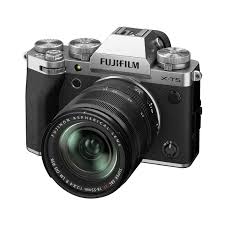As a part-time nature photographer living in Boston, where the seasons shift dramatically and each one offers unique photographic opportunities — from the moody, snow-laden trees of winter in the Arnold Arboretum to the explosive colors of fall in the Middlesex Fells — the Fujifilm X-T5 has become more than just a tool. It’s a partner in capturing those fleeting moments where light, texture, and wildlife collide.
Build and Handling
The X-T5 returns to a more compact form reminiscent of the X-T3, shedding some of the extra bulk of the X-T4. For someone who often hikes or wanders for hours in places like Mount Auburn Cemetery or the Blue Hills Reservation, this matters. Weighing in at around 557g (body only, with battery and card), the X-T5 feels light yet robust — the magnesium alloy body is weather-sealed, which is critical for New England’s erratic climate. One moment it’s sunny, the next it’s a drizzle rolling in off the Charles River, but the X-T5 doesn’t flinch.
Sensor and Image Quality
The X-T5 features a 40.2-megapixel back-illuminated X-Trans CMOS 5 HR sensor. This was a huge draw for me. I often crop wildlife shots taken at a distance or need to bring out detail in sweeping landscapes. The resolution this sensor provides is phenomenal. The detail, especially when paired with Fujinon lenses like the XF 70-300mm or the 16-55mm f/2.8, is razor-sharp and holds up beautifully even in tight crops.
Dynamic range performance is excellent. Sunrise shots at Castle Island or evening mist at Walden Pond present complicated lighting scenarios. The X-T5 handles both shadows and highlights gracefully, with plenty of flexibility in post-processing.
Autofocus Performance
The autofocus system, built around Fujifilm’s intelligent hybrid AF with 425 phase detection points, has been significantly improved. Subject detection for animals and birds — a key point for me — is fast and sticky, especially useful for the often-skittish squirrels and occasional red-tailed hawks I encounter. While it’s not quite on the level of some full-frame sports-oriented systems, it’s fast enough for most of my needs.
The eye detection for animals has genuinely improved over the previous generation, and I now find myself trusting the AF system more and more even in challenging light or partially obstructed environments, such as branches or reeds.
IBIS and Low Light Performance
The in-body image stabilization (IBIS) offers up to 7 stops of compensation. Shooting handheld at dawn in the Arnold Arboretum or dusk along the Esplanade used to mean compromises in ISO or shutter speed. Now, I can shoot at slower shutter speeds with less fear of motion blur. Combined with Fujifilm’s excellent noise reduction algorithms, I can push ISO into the 3200–6400 range without worry.
Viewfinder and LCD
The 3.69-million dot OLED EVF offers a clear, immersive viewing experience, and its refresh rate is snappy and responsive. It’s especially helpful when tracking birds or composing a landscape with fine precision. The rear LCD is a 3-inch 1.84-million-dot three-way tilting screen. I initially missed the fully articulating screen of the X-T4, but for tripod work — especially when shooting low-angle forest floors or overhead tree canopies — this tilt screen feels more intuitive and stable.
Battery Life and Storage
Battery life, using the NP-W235, is solid. On a typical morning shoot, say at the Boston Harbor Islands, I can comfortably get through 600+ shots with moderate chimping and some 4K video sprinkled in. It supports dual UHS-II SD card slots, allowing for RAW/JPEG separation or instant backup, which gives peace of mind when you’re deep in the woods or along coastal paths.
Video Capabilities
While I primarily shoot stills, the X-T5 is no slouch in the video department. It offers 6.2K at 30fps and 4K HQ oversampled from 6.2K. The quality is cinematic, with a rich, detailed rendering that pairs well with Fujifilm’s film simulations. For quick clips of waves rolling in at Plum Island or wind brushing tall grass, the X-T5’s video is more than capable.
Fujifilm Ecosystem and Film Simulations
One of the joys of Fujifilm is the built-in film simulations. Classic Chrome, Velvia, and Nostalgic Neg bring different moods that align with New England’s shifting palette. They often reduce my time in Lightroom — sometimes a JPEG straight from the camera is enough. And the X-T5’s ability to process RAWs in-camera with custom recipes lets me experiment on the fly, even while riding the T home from a shoot.
Connectivity and Workflow
Wi-Fi and Bluetooth integration has become more stable. I often use the Fujifilm XApp to transfer quick shots to my phone for posting or archiving. The USB-C port allows both charging and tethering, and the HDMI out supports external recorders if I ever want to dive deeper into video work.
Conclusion
As a part-time nature photographer in Boston, the X-T5 strikes an ideal balance between portability, power, and creative flexibility. It respects the craft while bringing modern imaging power into the field. Whether I’m chasing light through the fog at Jamaica Pond or waiting for a great egret to move in the wetlands of Belle Isle Marsh, this camera consistently delivers. It’s not just a pleasure to use — it’s a reminder of why I started photographing nature in the first place.
